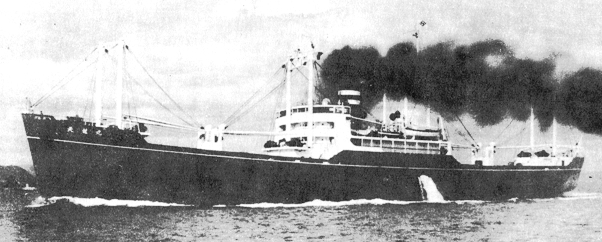RIKUGUN YUSOSEN
 (Sister TENRYU MARU prewar)
(Sister TENRYU MARU prewar)
SANKO MARU:
Tabular Record of Movement
© 2017 Bob Hackett
1936:
Innoshima (Hiroshima). Laid down by Osaka Ironworks K.K. shipyard as Yard No. 1301, a 4,958-ton passenger-cargo ship.
29 May 1937:
Launched and named SANKO MARU. [1]
15 August 1937:
Completed.
27 October 1937:
Requisitioned by the Imperial Army (IJA) and converted to a troop transport. Allotted IJA No. 394.
10 January 1939:
Released back to her owners.
14 October 1941:
Re-requisitioned by the IJA.
29 July 1942:
SANKO MARU departs Manila for Palawan carrying 346 prisoners-of-war (POWs). Three POWs die en route.
31 July 1942:
Arrives at Palawan. Disembarks the remaining POWs.
23 March 1943:
SANKO MARU, an IJA chartered “slow transport” limited to 10 knots, is attached directly to Fifth Fleet. She carries a cargo of food, ammo and building materials.
Vice Admiral Hosogaya Boshiro's [36] Fifth Fleet sorties from Paramushiro, Kuriles for Attu, Aleutians in three groups. SANKO MARU is first to sortie because of her slow speed escorted by Fifth Fleet's destroyer USUGUMO. Next to sortie that same day are light cruiser ABUKUMA, armed 7000-ton converted merchant cruisers ASAKA and SAKITO MARUs and DesDiv 6's IKAZUCHI and INAZUMA, DesDiv 21's HATSUSHIMO and WAKABA.
24 March 1943:
Last to sortie is the main body of the Fifth Fleet comprised of cruisers NACHI (F) and MAYA and light cruiser TAMA.
25-26 March 1943:
Very bad weather is encountered and little progress is made.
26 March 1943: The Battle of the Komandorski Islands:
North Pacific, off the Kamchatka Peninsula, Siberia. During the afternoon, the second two groups rendezvoused. Rendezvous was set for 0100, 27 March, and a radio message to this effect was sent out. The force was in column, in order from van to rear: cruisers NACHI (F) and MAYA, light cruiser TAMA, destroyers WAKABA and HATSUSHIMO, light cruiser ABUKUMA , destroyers IKAZUCHI and heavily armed 7000 ton converted merchant cruisersASAKA and SAKITO MARUs, with destroyer INAZUMA in the rear. They are on a northerly course approaching a rendezvous with slow freighter SANKO MARU which had been sent ahead with destroyer USUGUMO when one of the ships in the rear signals that two silhouettes are to the south at a distance of 6000 to 8000 meters.
The report is passed to NACHI that USUGUMO and SANKO MARU had been sighted. But at 0313, the Japanese discover that it is the enemy that bore 160 degrees true, distance 13˝ miles. Because of the high bridge on NACHI, she probably discovers the enemy at the same time, or before. NACHI immediately orders the transports to retire to the west. The course of the column is changed to east and then southwards, and orders are given to take battle formation.
One of NACHI's three planes had been left behind for overhaul and MAYA had none of her three planes with her. On contact with the Americans, NACHI's two planes are ordered launched. At 0540, before they can be catapulted, NACHI's main battery opens fire. The gun blast damages the two-seat Type 0 spotter plane on the starboard catapult, probably a Nakajima E8N2 "Dave". It has to be jettisoned. The remaining three-seat E13A1 "Jake" on the port catapult is launched. It carries out spotting duties throughout the action and then flies to Attu, but crashes on landing.
A few minutes after 0800, first one heavy cruiser and then another was made out, rapidly approaching gunfire range on Rear Admiral (later Vice Admiral) Charles H. McMorris' (former CO of SAN FRANSCISCO, CA-38) Task Group 16.6's USS RICHMOND (CL-9)(F), SALT LAKE CITY (CA-25) and destroyers BAILEY (DD-492), DALE (DD-353), MONAGHAN (DD-354) and COGHLAN (DD-606) starboard bow; the auxiliaries are now on his port bow. And soon a couple of light cruisers hove into sight. McMorris had run into Admiral Hosogaya's entire fleet.
Admiral McMorris engages Fifth Fleet cruisers NACHI (F), MAYA, TAMA and ABUKUMA and two destroyers escorting Rear Admiral Mori Tomoichi's [42] Convoy "D" carrying troops and supplies for the isolated garrison on Attu. Once Admiral McMorris realizes he is up against a superior Japanese force he makes the prudent decision to turn away. McMorris is able to draw away the escort vessels, while transports ASAKA and SANKO MARUs and destroyer USUGUMO, return to Kataoka.
NACHI launches Type 93 "Long Lance" torpedoes at McMorris' force, but scores no hits. In a four-hour running gun battle, SALT LAKE CITY and BAILEY are damaged by gunfire. The other American destroyers are not damaged. Five shells hit and damage NACHI. Fourteen crewmen are killed. MAYA's No. 1 gun turret is knocked out. More importantly, McMorris succeeds in causing the Japanese to abort their resupply mission of their garrison on Attu.
28 March 1943:
Arrives at Paramushiro with the convoy. Disgraced, Hosogaya is relieved of command and forced to retire. Vice Admiral Kawase Shiro (former XO of KIRISHIMA) assumes command of the Fifth Fleet.
9 December 1943:
Hitokappu Bay, Etorofu Island, Kuriles. SANKO MARU is sunk by gunfire.
Author's Note:
Thanks go to Erich Muehlthaler of Germany.
Bob Hackett
Back to IJA Transports





